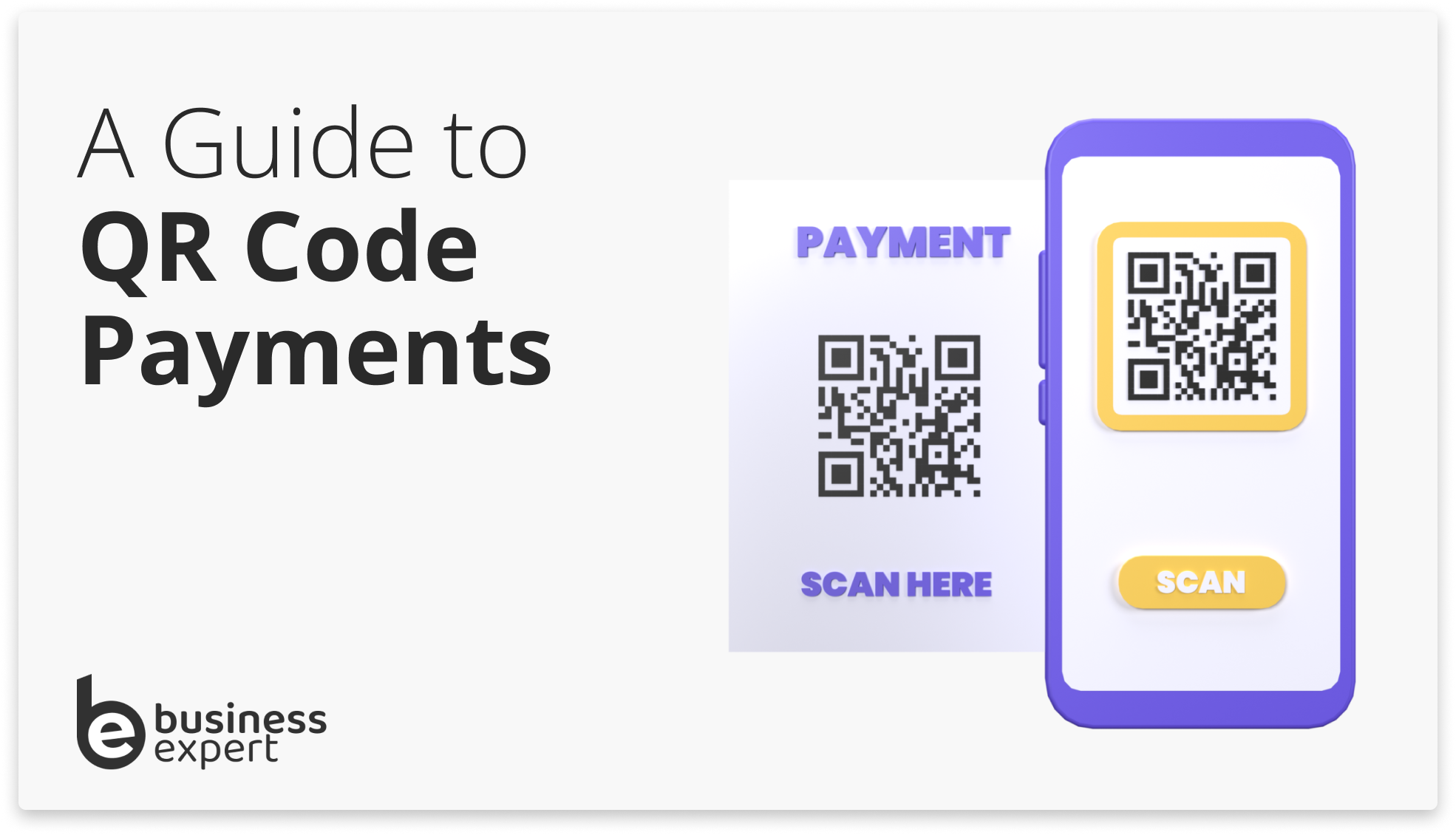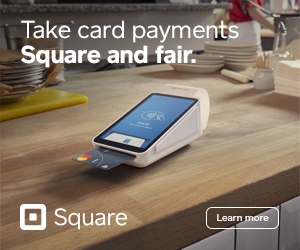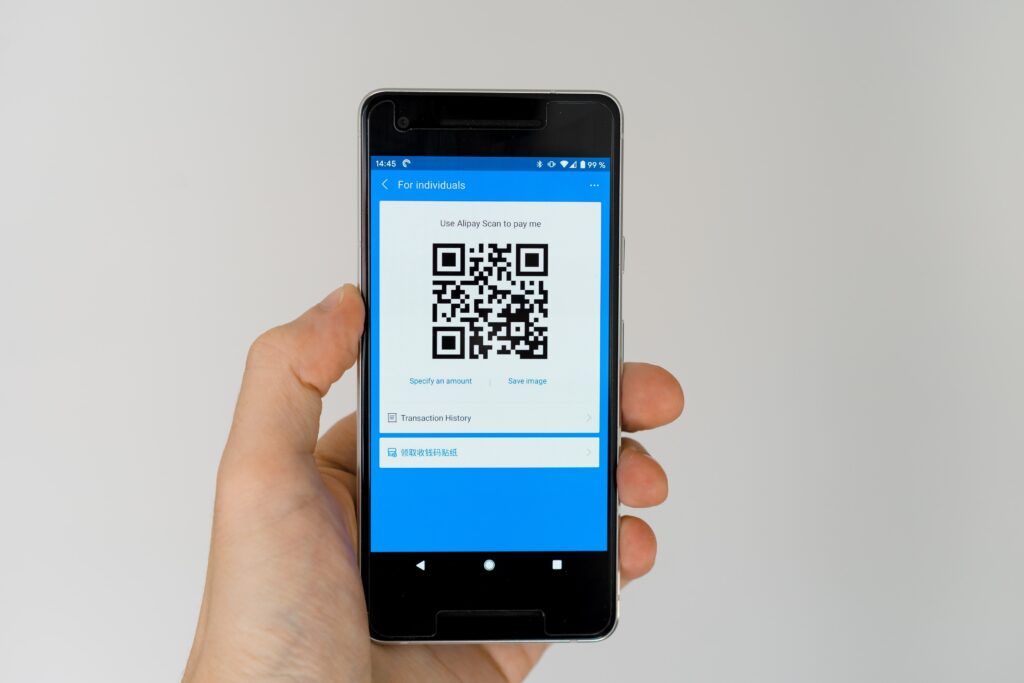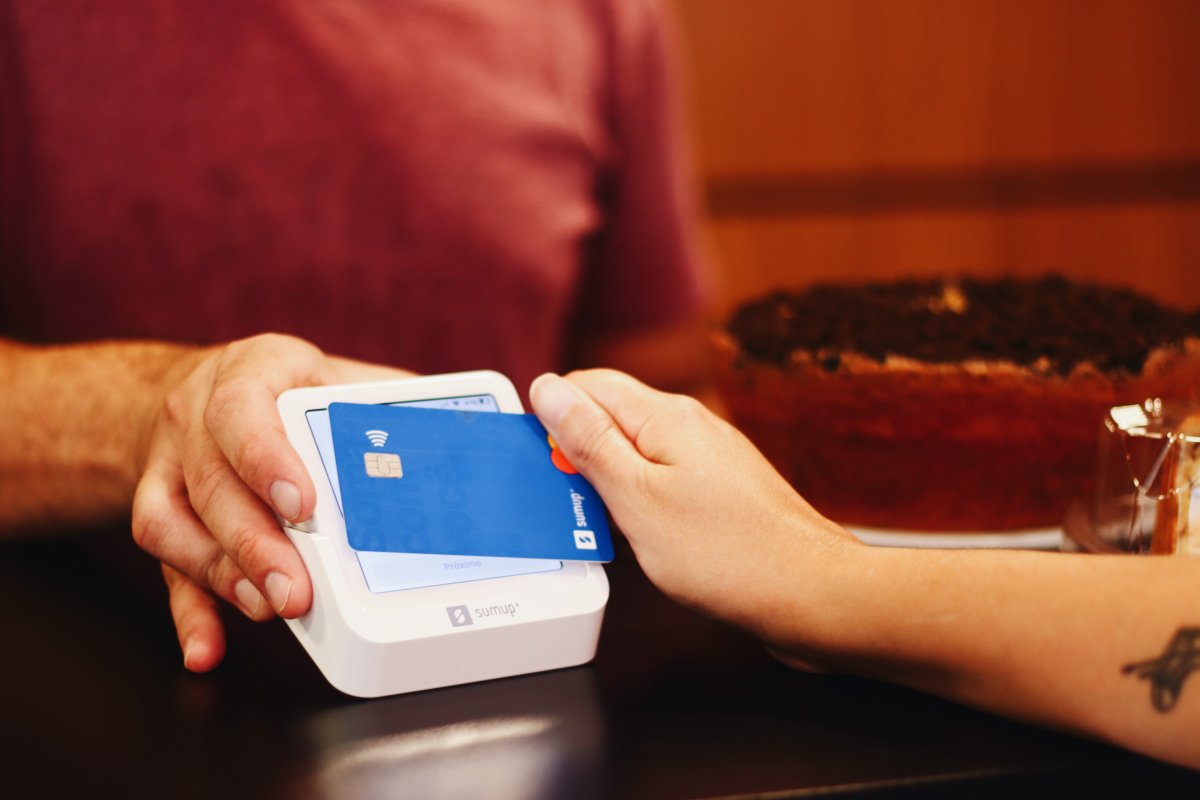Driven by the rising use of smartphones, QR codes are a fast-expanding area of the digital payments sector. In fact, by 2025, global spending using QR code payments will reach over $ 3 trillion.
Those black-and-white square patterns are now found in advertisements, on packaging, and even on gravestones. But what exactly are QR codes, and how do they work? We’ll cover how to create, display and scan codes for seamless checkout experiences.


What are QR Codes?
QR codes, or Quick Response codes, are two-dimensional barcodes that store information. Originally developed for the automotive industry, they have found widespread use in various sectors, including retail and hospitality.
Comprising black squares arranged on a white square grid, QR codes can store a variety of data types, including numeric, alphabetic, binary, and special characters. The information is extracted using an imaging device, such as a camera, which scans the QR code and interprets the pattern.
The rise of QR codes is inextricably linked with that of the smartphone. Mobile phones make it simple to access data quickly, be it a website link, product information, or, as is increasingly common, payment details.

How Does a QR Code Work?
QR code payments provide a simplified and secure transaction method that can easily be integrated into a merchant’s operational workflow.
The process begins with setting up a merchant account with a payment service provider that supports QR code payments. Providers of this kind are abundant, with all major payment processors now offering QR code capabilities.
After establishing a merchant account, the next step is to generate a QR code using the provider’s platform. This code encapsulates all the necessary data for taking a payment, ranging from account identifiers to transaction details.
Once generated, the key task is to display this QR code where it will capture the attention of prospective customers. For online businesses, embedding the code on relevant web pages is common practice, while physical stores often opt for displaying it at the checkout counter.
The actual payment process is initiated when a customer scans the displayed QR code using either a smartphone camera or a specialized application. This action directs them to a secure payment environment where they can complete the transaction.
How are QR Codes Used for Payments
Here are several examples of how QR codes are used in different sectors for payments:
- Retail and E-commerce: QR codes at checkout allow customers to pay for purchases by scanning, streamlining the transaction process without cash or cards.
- Banking and Finance: Banks utilise QR codes in their apps for easy peer-to-peer transfers and bill payments, enhancing mobile banking convenience.
- Transport and Logistics: Public transport systems adopt QR codes for ticket purchases and validations, simplifying access to buses, trains, and subways.
- Hospitality and Tourism: Hotels and tourist attractions use QR codes for check-ins and ticketing, offering a contactless, efficient service experience.
- Healthcare: Patients can pay for consultations and procedures by scanning QR codes, reducing wait times and contact at payment desks.
- Education: Schools and universities implement QR codes for tuition and fee payments, making the process more accessible for students and parents.
- Utilities and Services: QR codes facilitate the payment of utility bills and services, allowing consumers to effortlessly manage and settle their monthly dues.
- Food and Beverage: Restaurants and cafes offer QR codes for customers to view menus, order, and pay from their tables, enhancing the dining experience with contactless service.
- Entertainment and Leisure: Cinemas, amusement parks, and event organisers use QR codes for ticket sales and entry, streamlining access and reducing queues.
- Charities and Non-profits: Organisations accept donations via QR codes, making it easier for supporters to contribute to causes they care about with simple scans.
How Businesses Can Use QR Codes
QR codes offer a versatile tool for businesses to enhance customer interaction, streamline operations, and boost marketing efforts. Here’s how they can be effectively utilized across various functions:
Contactless Payments
QR codes enable businesses to offer contactless payment options, significantly reducing the time customers spend at checkout and minimizing physical contact. By scanning a QR code, customers can pay directly from their mobile wallets, enhancing the safety and efficiency of transactions.
Promotions and Discounts
Businesses can use QR codes to deliver promotions and discounts directly to their customers. Placing QR codes in strategic locations like store windows, at the cash register, or on product packaging, customers can scan to access exclusive deals, encouraging more engagement and repeat business.
Customer Surveys
Gathering customer feedback is crucial for any business looking to improve its services or products. QR codes linked to customer surveys can be placed on receipts, tabletops, or the checkout area, making it easy for customers to provide valuable feedback directly from their smartphones.
Digital Menus
In the food and beverage industry, QR codes have become a popular method for accessing digital menus. Customers can scan a QR code placed on the table or at the entrance to view the menu on their phones, reducing the need for physical menus and streamlining the ordering process.
Registration and Check-In
Events, hotels, and service-based businesses can use QR codes to simplify the registration and check-in processes. Customers can scan a QR code to fill out registration forms, check into events, or access key information, saving time and reducing the need for physical paperwork.
Information Sharing
QR codes can be a powerful tool for sharing information about products or services. By scanning a QR code, customers can access detailed product information, tutorials, or even how-to videos, enriching their shopping experience and providing them with all the information they need to make an informed decision.
Social Media Engagement
Enhancing social media engagement is another innovative use of QR codes. Businesses can link QR codes to their social media profiles or specific campaigns, making it easier for customers to follow, like, or share content, thereby boosting the business’s online presence and engagement.
Loyalty Programs
Integrating QR codes with loyalty programs allows businesses to simplify the process of earning and redeeming rewards. Customers can scan a QR code to track their purchases and points, access their loyalty account, or redeem rewards, enhancing the overall customer experience and encouraging loyalty.
Benefits of Using QR codes for Payments
The adoption of QR codes for payments brings several advantages to any business.
Firstly, QR codes speed up the transaction process. There’s no need for physical cards, cash, or even manual entry of payment details. A simple scan suffices, reducing the time spent at the checkout.
Secondly, QR codes are cost-effective. Unlike Point of Sale (PoS) systems that require specialized hardware and software, generating a QR code for payment is generally inexpensive.
Thirdly, QR codes offer flexibility. They can be displayed in various formats—be it printed on a receipt, presented on a digital screen, or even advertised on a billboard. This adaptability makes it easier for businesses to integrate QR codes into their existing operations without major upheaval.
Finally, QR codes can enhance the customer experience. With the rise in smartphone usage, many customers find it convenient to pay via QR codes, as it eliminates the need to carry cash or cards.
What is the Difference Between a QR Code and a Contactless Payment?
QR codes and contactless payments are both convenient ways to make payments, but they work in different ways.
Contactless payments use Near-Field Communication (NFC) technology to transfer data between two devices when they are close together. To make a contactless payment, you simply tap your contactless card or smartphone on a payment terminal. Contactless payments are fast and easy, but they require specialized hardware, which can be expensive for businesses to implement.
QR codes are two-dimensional barcodes that can be scanned using a smartphone camera. To make a QR code payment, you simply scan the code provided by the merchant. QR code payments do not require any specialized hardware, making them a more cost-effective option for businesses.
Another difference between QR codes and contactless payments is the transaction flow. In contactless payments, the payment terminal typically initiates and controls the transaction. In QR code payments, either the payer or the payee can initiate the transaction. This offers additional flexibility; for example, a customer can scan a merchant’s QR code to pay, or a merchant can scan a customer’s QR code to request payment.
QR codes can also be used to handle more complex transactions than contactless payments. For example, QR codes can incorporate discounts, loyalty points, and other variables.
Here is a table that summarizes the key differences between QR codes and contactless payments:
| Feature | QR codes | Contactless payments |
|---|---|---|
| Technology | Two-dimensional barcode | Near-Field Communication (NFC) |
| Hardware required | Smartphone camera | NFC-enabled payment terminal |
| Transaction flow | Payer or payee can initiate | Payment terminal initiates |
| Complexity of transactions | Can handle complex transactions | Cannot handle complex transactions |
How do I collect QR code payments?
To collect QR code payments in the UK, you will need to:
- Choose a payment processor. There are many payment processors that support QR code payments in the UK. Compare the different features and pricing plans to choose the one that is best for your business.
- Generate a QR code. Once you have chosen a payment processor, you can generate a QR code through their platform. This QR code will contain the necessary information for customers to make payments to your account.
- Display the QR code. Display the QR code in a prominent location where customers can easily scan it. This could be near the checkout counter, on the dining table in a restaurant, or even on your website for online transactions.
- Train your staff. Make sure your staff are familiar with the QR code payment process so they can assist customers if needed. This can help to make the transaction process smooth and error-free.
Creating a QR Code for Payments
Integrating QR codes into your payment process is a strategic move for enhancing transaction efficiency. Here is a step-by-step guide on how to create a QR code for accepting payments:
- Select a QR Code Generator: There are multiple QR code generators available online, some of which are dedicated specifically to payment codes. Choose one that is reputable and ideally recommended by financial institutions.
- Input Transaction Details: After selecting a generator, you’ll be prompted to enter the details relevant to the payment. This can include your business name, account number, and any other pertinent information.
- Set Payment Parameters: If you opt for a dynamic QR code, you’ll have the flexibility to set specific parameters such as discounts or taxes. This is useful for variable transactions.
- Generate the Code: Once all the necessary details are inputted, proceed to generate the QR code. This will create a digital image file that can be printed or displayed electronically.
- Test the Code: Before rolling it out for public use, conduct multiple tests to ensure it scans correctly and directs to the intended payment gateway.
- Secure the Code: It is crucial to secure the generated code, especially if it’s dynamic, to prevent any unauthorised modifications. Use security features like access controls or encryption, as provided by your QR code generator or payment processor.
Creating a QR code is a straightforward process but does require attention to detail to ensure it functions as intended and remains secure.

Are QR codes a safe payment method?
Safety is a critical concern for both consumers and business owners when it comes to financial transactions. So how do QR code payments measure up in terms of security?
- Encryption: QR codes for payments are encrypted, making the data they carry secure and hard to misuse without complex decryption.
- Two-Step Verification: Payment apps often require extra authentication, like a password or biometric verification, adding another security layer.
- Transaction Alerts: Users and businesses receive instant notifications for transactions, helping quickly identify unauthorized activity.
- Limited Exposure: QR codes reduce the risk of fraud by allowing payments without physical card handling or PIN entry.
- Vendor Credibility: It’s vital to check that the QR code is from a trusted source to avoid scams.
- Software Updates: Regular updates of payment apps ensure the latest security features are in use.
While no payment method is completely foolproof, QR codes do offer multiple layers of security that make them a safe option for conducting transactions.
Displaying Your QR Code for Customers
How you display your QR code for customer payments matters.
It should be visible and easy to find, like at checkout counters or on table tents in restaurants. Make sure the QR code is clear and easy to read; any damage could cause scanning issues.
Include simple instructions for first-time users. The QR code size is important too; it needs to be big enough for smartphones to scan easily but not too big to handle.
Keep it secure, especially in public spaces, to prevent tampering.
If there are multiple payment options, label each QR code clearly to avoid mix-ups. For dynamic QR codes that change, ensure they’re always up to date, possibly with automated updates.
Tips for Successful QR Code Payments
Implementing QR code payments in your business can offer substantial benefits, but success often lies in the details. Here are some tips to optimise your QR code payment system:
- User Education: Familiarise your staff and customers with the process. The more comfortable they are with the system, the more likely they are to use it regularly.
- Quality Control: Periodically test your QR codes to ensure they are functioning correctly. Any issues should be addressed promptly to maintain a smooth operation.
- Feedback Loop: Create a mechanism to gather feedback from both customers and staff. This can provide insights into what is working well and what needs improvement.
- Transaction Limits: Consider implementing transaction limits for QR code payments, as an additional safety measure against potential misuse or errors.
- Customisation: Utilise the ability to customise QR codes to include branding elements, making it more recognisable and trusted by your customers.
- Promotions: Leverage QR codes for promotional activities. For example, you could offer discounts for transactions completed via QR code payments, encouraging more customers to try the method.
- Data Analysis: Use the transaction data to gain business insights. QR code payments often provide rich datasets that can be analysed to understand customer behaviour, popular products, or peak transaction times.
- Compliance: Ensure your QR code payment system is compliant with relevant local and international financial regulations to avoid any legal complications.
QR Code Payment FAQs
Yes, many payment processors allow for the customisation of QR codes to include brand colors, logos, or other distinguishing features. This enhances brand recognition and can make the payment process more visually cohesive for customers.
Transaction limits can vary depending on the payment processor and the country’s financial regulations. However, it is common for merchants to set their own transaction limits as an additional security measure. Be sure to inquire about this with your payment processor.
Many modern payment processors can generate QR codes that are capable of accepting multiple currencies. If your business caters to an international customer base, this feature could be advantageous.
Most dynamic QR codes can be updated remotely, reducing the risk of displaying outdated information. However, if a customer scans an incorrect or outdated code, the transaction will likely fail to process, and the customer will need to scan the correct, updated code.
QR codes can be used for more than just transactions. They can also direct customers to promotional pages, special offers, or even surveys. This multifunctionality makes them a versatile tool for enhancing customer engagement strategies.
Static QR codes, which contain fixed information, do not expire. Dynamic QR codes, which can be updated with new information, may have an expiration setting based on the service provider’s guidelines or your own preferences.
Many payment processors offer analytics features that can help you understand transaction trends, customer preferences, and other behavioural insights. This data can be invaluable for refining your business strategy.



